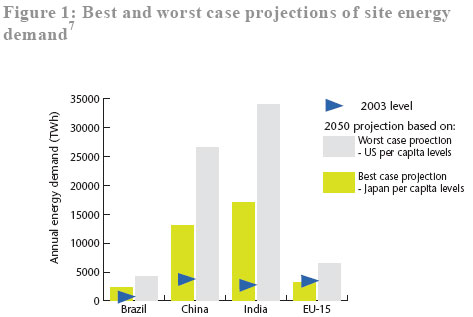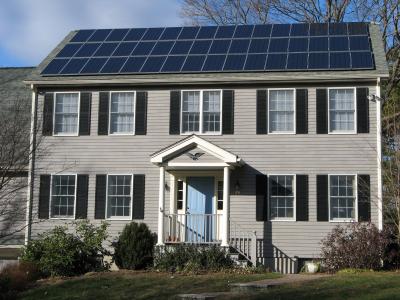Could this be why people think it is so expensive to build green buildings? A new survey finds green costs overestimated by 300%! Key players in real estate and construction misjudge the costs and benefits of “green” buildings, creating a major barrier to more energy efficiency in the building sector, a new study by the World Business Council for Sustainable Development (WBCSD) reports.
Respondents to a 1400 person global survey estimated the additional cost of building green at 17 percent above conventional construction, more than triple the true cost difference of about 5 percent. At the same time, survey respondents put greenhouse gas emissions by buildings at 19 percent of world total, while the actual number of 40 percent is double this.
The findings are disclosed in a new report titled Energy Efficiency in Buildings: Business Realities and Opportunities (pdf), which summarizes the first phase of the WBCSD’s project. The project is co-chaired by Lafarge and United Technologies Corporation. Other participating companies are CEMEX, DuPont, Electricité de France, Gaz de France, Kansai, Philips, Sonae Sierra, and Tepco.
So all those homes going up in China and India, if they start using energy the way we in the USA do the world is basically screwed. But it doesn’t have to go down like that. “The global construction boom in the developing world has created a tremendous opportunity to build differently and dramatically decrease otherwise energy demands,” said United Technologies Corporation Chairman and Chief Executive George David. “Existing technologies combined with common sense design can increase energy efficiency by 35 percent and reduce heating costs by 80 percent for the average building in industrialized markets,” he said.

“The world is undergoing rapid transformation, with strong demographic and economic growth driving a move towards urbanization on an unprecedented scale. We as industry leaders have a responsibility to ensure that this growth is achieved in a sustainable manner,†said Bruno Lafont, Chairman and Chief Executive Officer of Lafarge.
The way we build buildings will play a large role. People in the business of building homes need to know the kind of impact they can have on the future. “Life cycle analysis shows that 80% to 85% of the total energy consumption and CO2 emissions of a building comes from occupancy through heating, cooling, ventilation, and hot water use. If we want to make an impact on climate change, we therefore need to tackle this challenge. Combining the right materials when designing a building envelope can greatly reduce a building’s energy requirements, increase its life span and ensure consistent performance over time,†he said.
Industry alone will not solve the problem. “In order to achieve a step change in energy efficiency in buildings, there is a need for strongly supportive policies and regulatory frameworks. Governments and local authorities need to develop sound policies,” said Bjorn Stigson, President of the World Business Council for Sustainable Development. Building codes and zoning rules could go a long long way towards solving this problem.
The study also found that fewer than one in seven industry respondents has participated directly in a green building project. Involvement ranges from a high of 45 percent in Germany to just 5 percent in India. About 20 percent of architects, engineers and developers have been involved in green building projects, compared to just 9 percent of owners and tenants.
Buildings already represent approximately 40 percent of primary energy use globally and energy consumption in buildings is projected to rise substantially in the world’s most populous and fast growing countries such as China and India .
The study highlights opportunities to promote green building know how and technologies as the WBCSD pushes for zero net energy construction worldwide. Zero net energy buildings will reduce demand by design, be highly efficient and generate at least as much energy as they consume. Their Energy Efficiency in Buildings Project is a three year initiative to assess the environmental impacts of buildings and develop means to achieve zero net energy use for residential and commercial buildings.
We have covered revolutions through building before, click here for further reading.

Great Article- Building Affordable and Sustainable is a challenge for developers our team is doing a project in Baja California Sur, Mexico that has many eco elements while keeping a low entry price.
Visit http://www.mesaverdebaja.com
This article show me the exact pros and cons of Green Building, i have read more then 5 articles related to this only taking about the benefits of Green Building. Yes everyone should disclose the exact cost.